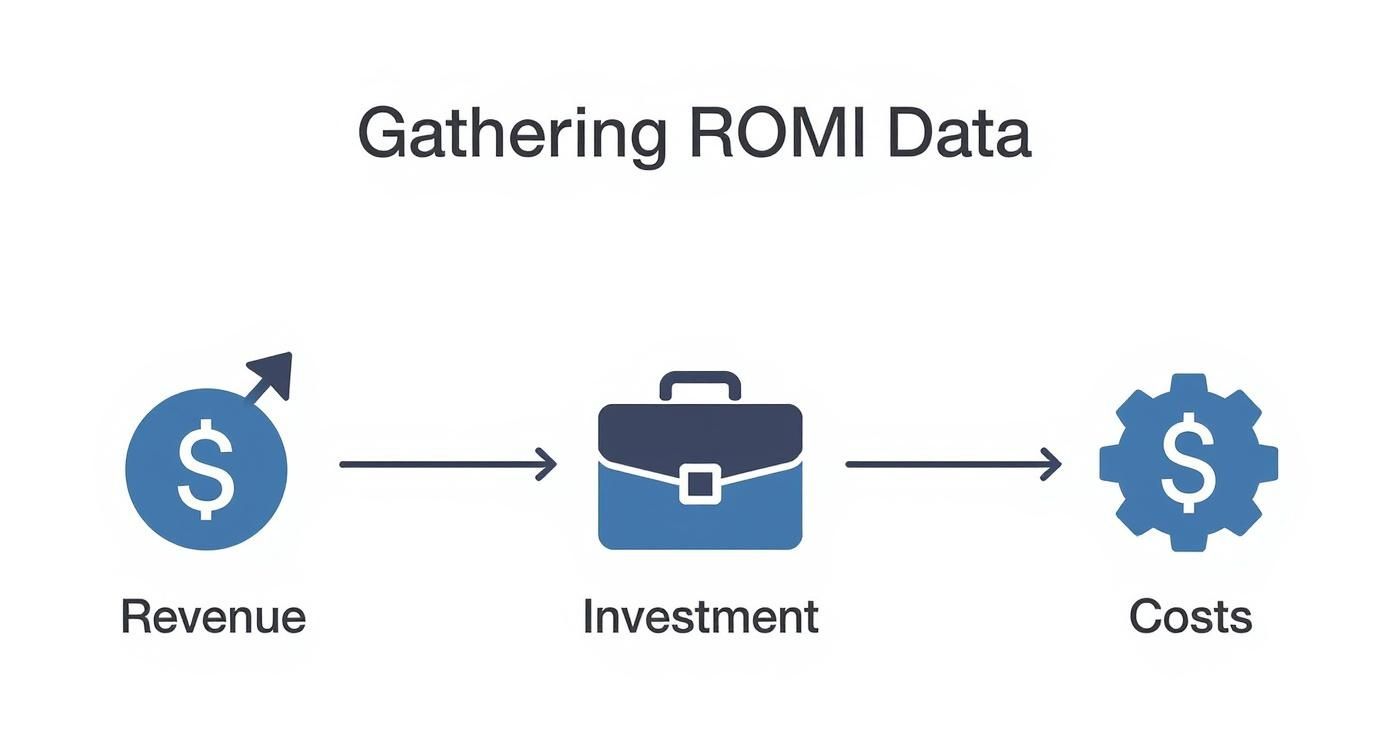The return on marketing investment formula is a pretty straightforward calculation, but it’s one of the most powerful tools in a marketer’s toolkit: [(Gross Profit – Marketing Investment) / Marketing Investment] x 100.
At its core, this metric shows you exactly how much profit you’re generating for every dollar you put into your marketing. It’s the ultimate reality check.

Let's be honest—marketing spend can feel like a black box. You pour money into ads, content, and new campaigns, but connecting that budget to actual business results is a constant challenge. This is where the Return on Marketing Investment (ROMI) formula cuts through the noise.
Think of it like a chef analyzing a new dish. It’s not just about how many people ordered it (that’s like getting hung up on vanity metrics like clicks or likes). What really matters is how much profit that dish generated after you subtract the cost of all the ingredients.
ROMI does the exact same thing for your marketing. It forces you to look past the surface-level data and focus on what truly keeps the lights on: profitability.
Unlike broader business metrics, the ROMI formula is specifically designed to isolate the performance of your marketing activities. This is a huge deal, because it helps you:
Essentially, ROMI separates the impact of your marketing from everything else happening in the business, giving you a clear, precise measure of your team’s contribution to the bottom line. It's often confused with other metrics, but knowing the key differences between ROI vs. ROAS is crucial for accurate analysis.
To help you get the calculation right every time, here’s a quick breakdown of each part of the formula.
By plugging in your own numbers, you can quickly see just how effective—or ineffective—your marketing efforts truly are.
Let’s walk through a simple example. Imagine your latest campaign generated $80,000 in revenue. Your cost of goods sold (COGS) for those products was $40,000, which means your gross profit is $40,000.
You spent a total of $10,000 on the marketing campaign itself.
Using the formula:( $40,000 Gross Profit – $10,000 Marketing Investment ) / $10,000 Marketing Investment
This gives you 3. To express it as a percentage, you just multiply by 100.
The result is a 300% ROMI. In other words, for every $1 you spent on that campaign, you generated $3 in pure profit. Now that's a number you can take to your leadership team with confidence.
Any good calculation starts with the right ingredients. It’s like baking a cake—if you mismeasure the flour or sugar, the whole thing will be off. The same goes for the return on marketing investment formula; garbage data in, garbage results out. Using incomplete or sloppy numbers will give you a ROMI that’s dangerously misleading.
To get a number you can actually trust, you need to meticulously gather two key sets of data: the revenue you generated and your total investment. This sounds simple enough, but it’s more complex than just grabbing top-line numbers from your dashboard.
First things first: you need to attribute revenue directly back to your marketing efforts. I'm not talking about total company sales. I mean the specific dollars that a particular ad campaign or email sequence brought in. This is where proper tracking becomes non-negotiable. You have to be able to connect a customer’s purchase all the way back to the ad, email, or blog post that brought them to you in the first place.
This is why attribution is so critical. To learn more about how to connect actions to outcomes, our guide on what is UTM tracking is a great place to start.
A classic mistake is giving 100% of the credit to the last touchpoint. A customer might see a Facebook ad, click an email link a week later, and then do a Google search before finally buying. A sophisticated attribution model knows how to distribute that credit where it’s due.
This chart breaks down the different components you need to get an accurate ROI calculation.
As you can see, a precise calculation requires you to account for direct campaign costs as well as the broader financial context, like gross profit.
Next up is getting a complete picture of what you actually spent. This goes way beyond your ad spend. A true marketing investment includes every single cost tied to getting your campaigns out the door.
Think about all these common expenses:
When you gather these precise data points, you're setting the stage for a ROMI calculation that actually reflects the true financial impact of your marketing. No guesswork, just clarity.
Alright, you've gathered your data. Now it's time to put the return on marketing investment formula into practice. This isn’t about just plugging in numbers and getting a result; it's about seeing the story your marketing efforts are telling financially.
Let's walk through a real-world example to make this crystal clear.
Imagine an e-commerce brand, "Cozy Threads," that just wrapped up a social media campaign for a new sweater line. We're going to plug their results right into our formula: [(Gross Profit – Marketing Investment) / Marketing Investment] x 100.
First things first, we need to know how much revenue the campaign actually generated. Cozy Threads used their analytics and confirmed the campaign brought in $50,000 in sales. Simple enough.
Next up is Gross Profit. The cost of goods sold (COGS) for those sweaters—the actual cost to produce them—was $20,000. So, the calculation is straightforward:
Now, let's tally up every dollar spent to make this campaign happen.
With all our numbers in hand, we can finally solve for ROMI:[($30,000 - $8,000) / $8,000] x 100[$22,000 / $8,000] x 100 = 275%
In plain English, this means Cozy Threads generated $2.75 in profit for every $1 they spent on this campaign. Not bad at all.
This infographic helps visualize how the data flows from top-line revenue down to the final costs.

As you can see, getting an accurate ROMI is all about tracking revenue, investment, and your operational costs in a clear sequence. If you're focusing specifically on your ad performance, a dedicated return on ad spend calculator can give you a more granular look.
A 275% ROMI is more than just a number—it’s a powerful decision-making tool. It tells the team that their social media strategy is working, justifies the budget, and sets a clear benchmark for what "good" looks like on future campaigns.
To make sure you're applying the formula correctly every time, this guide on how to measure marketing ROI the right way is a fantastic resource for diving even deeper.
The return on marketing investment formula looks simple on paper, but a few hidden traps can easily lead to misleading results and poor strategic decisions. Getting an accurate number isn’t just about the math; it’s about sidestepping the common pitfalls that can throw off your entire calculation.
One of the biggest errors is faulty attribution. This happens when you give one channel all the credit for a sale, usually the last one a customer touched. Think about it: a buyer might see your ad on social media, read a blog post a week later, and finally purchase after clicking a link in an email. A last-touch model would incorrectly assign 100% of the revenue to that email, completely ignoring the critical role the other channels played. You can explore these complexities further by understanding the most common attribution challenges in marketing.
Another frequent mistake is focusing only on immediate sales while ignoring the customer lifetime value (CLV). A campaign might have a low initial ROMI, but if it attracts high-value customers who make repeat purchases for years, its true return is much, much higher.
By overlooking CLV, you risk cutting marketing channels that are actually building a loyal, profitable customer base over the long term. This short-sighted approach can starve your business of future growth.
Finally, many marketers mess up ROMI for products with long sales cycles. A customer might see an ad in January but not actually buy until April. If you only measure your ROMI after one month, the campaign will look like a total failure. It’s crucial to align your measurement window with your average sales cycle to get a true picture of performance.

If you’ve nailed the basic ROMI calculation, that's a great start. But let's be honest—it only tells you part of the story. A simple return on marketing investment formula gives you a snapshot in time, but to really drive long-term growth, you need to think bigger.
True performance analysis means moving beyond the first purchase. It requires you to look at the entire customer relationship, not just that initial transaction. This is where you graduate from simple math to strategic tools like Customer Lifetime Value (CLV) and incremental lift.
One of the best ways to level up your ROMI calculation is by bringing in Customer Lifetime Value (CLV). Instead of just measuring the profit from a single order, CLV predicts the total profit you'll earn from that customer over their entire relationship with your brand.
Think about it. A campaign might have a weak initial ROMI because it attracts customers who make small first-time purchases. But what if those same customers turn into loyal fans who buy from you again and again? Their long-term value could be massive. Calculating ROMI with CLV gives you a far more accurate picture of that campaign's true success.
Factoring in CLV shifts your perspective from short-term gains to sustainable, long-term profitability, helping you identify the marketing channels that attract the most valuable customers over time.
Another powerful concept is incremental lift. This metric isolates the sales that happened only because of your marketing, stripping out the revenue you would have generated organically anyway. It answers the million-dollar question: "Did my marketing actually cause this sale?"
To measure this accurately, you need a crystal-clear view of every single touchpoint a customer interacts with on their path to conversion. Understanding this journey is what attribution is all about, and it's a core focus of a comprehensive guide to multi-touch attribution. When you can separate true marketing impact from organic demand, you can finally prove your direct contribution to the bottom line.
By folding these advanced methods into your analysis, you move from basic reporting to strategic financial thinking, proving marketing's real value. For more ideas on how different marketing tools can influence your return, it’s worth exploring resources that explain how chatbots in marketing boost engagement and ROI.
Even after you get the hang of the return on marketing investment formula, you'll run into specific situations that make you scratch your head. Let's tackle some of the most common questions marketers have when they start putting ROMI to the test.
This is the million-dollar question, and the honest answer is: it depends. You'll often hear a 5:1 ratio (or a 400% return) thrown around as a solid benchmark, but that's far from a universal rule.
Think about it this way: a company selling high-margin software might be thrilled with a 3:1 ratio because their profit on each sale is huge. On the other hand, a low-margin e-commerce store might need to hit a 10:1 ratio just to stay afloat and fund growth.
The only "good" ROMI is one that works for your business. You need to define your own target based on your product costs, overhead, and what you consider profitable.
Trying to pin a direct sales number on a brand awareness campaign is a classic marketing headache. These top-of-funnel efforts aren't designed for immediate sales, so forcing a direct ROMI calculation on them is like trying to fit a square peg in a round hole.
Instead, you have to look at proxy metrics to see the ripples they create.
For brand campaigns, stop looking for direct purchases. Instead, track metrics like a jump in branded search traffic, a rise in direct visits to your site, or more engagement on your social channels. You can then use multi-touch attribution to connect these early touchpoints to the sales they influence down the road.
This approach helps you prove that those "fluffy" brand activities are actually teeing up the final sale.
The right timing for calculating ROMI depends entirely on your sales cycle and the type of campaign you're running. There’s no one-size-fits-all schedule.
The key is consistency. Regular measurement is what allows you to spot trends, compare performance over time, and make smart tweaks to your strategy.
Ready to get crystal-clear attribution and finally see your true marketing ROI? Cometly provides the tools you need to track every dollar from ad spend to revenue, so you can stop guessing and start scaling. Learn more and get started at Cometly today!
Learn how Cometly can help you pinpoint channels driving revenue.
.svg)
Network with the top performance marketers in the industry